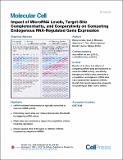Impact of MicroRNA Levels, Target-Site Complementarity, and Cooperativity on Competing Endogenous RNA-Regulated Gene Expression
Author(s)
Denzler, Rémy; Title, Alexandra C.; Stoffel, Markus; McGeary, Sean Edward; Agarwal, Vikram; Bartel, David; ... Show more Show less
Download1-s2.0-S1097276516305767-main.pdf (2.951Mb)
PUBLISHER_CC
Publisher with Creative Commons License
Creative Commons Attribution
Terms of use
Metadata
Show full item recordAbstract
Expression changes of competing endogenous RNAs (ceRNAs) have been proposed to influence microRNA (miRNA) activity and thereby regulate other transcripts containing miRNA-binding sites. Here, we find that although miRNA levels define the extent of repression, they have little effect on the magnitude of the ceRNA expression change required to observe derepression. Canonical 6-nt sites, which typically mediate modest repression, can nonetheless compete for miRNA binding, with potency ∼20% of that observed for canonical 8-nt sites. In aggregate, low-affinity/background sites also contribute to competition. Sites with extensive additional complementarity can appear as more potent, but only because they induce miRNA degradation. Cooperative binding of proximal sites for the same or different miRNAs does increase potency. These results provide quantitative insights into the stoichiometric relationship between miRNAs and target abundance, target-site spacing, and affinity requirements for ceRNA-mediated gene regulation, and the unusual circumstances in which ceRNA-mediated gene regulation might be observed. Keywords:
competing endogenous RNA; miRNA; target abundance; cooperatively;
gene regulation; base pair complementarity; miRNA degradation
Date issued
2016-10Department
Massachusetts Institute of Technology. Computational and Systems Biology Program; Massachusetts Institute of Technology. Department of BiologyJournal
Molecular Cell
Publisher
Elsevier BV
Citation
Denzler, Rémy et al. “Impact of MicroRNA Levels, Target-Site Complementarity, and Cooperativity on Competing Endogenous RNA-Regulated Gene Expression.” Molecular Cell 64, 3 (November 2016): 565–579 © 2016 The Authors
Version: Final published version
ISSN
1097-2765
1097-4164